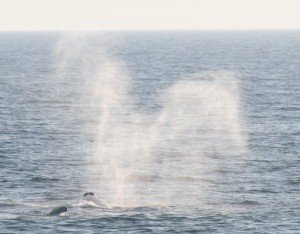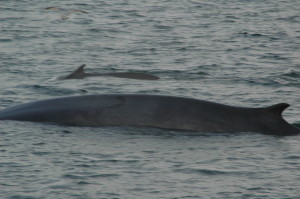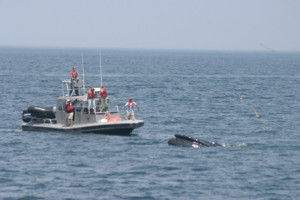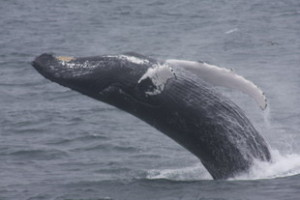Naturalist Notebook’s 2008 Year in Review
In April, our whale watching season started with a bang. Drawn by reports of record numbers of North Atlantic right whales in Cape Cod Bay in late winter, people flocked to Provincetown in droves to try to catch a glimpse of these endangered behemoths, whose V-shaped spouts could often be seen from Herring Cove and Race Point beach. Right whales are so named because they were considered the “right” whale to hunt. Weighing in at over 60 tons, they yielded a great deal of oil for commercial whalers. Additionally, their relatively slow speed, their tendency to feed at the surface, combined with the fact that they float after being killed, made them a prized target for the whalers leaving the ports in Provincetown, New Bedford, and Nantucket, among others.
V-Shaped spout of a right whale
The North Atlantic right whales were so heavily hunted, that there populations were depleted to the point that even after several decades of protection, there population is estimated to fall between 350 and 400 individuals to date. However, this past April we had approximately half the population visit Cape Cod Bay to feed upon tiny crustaceans known as copepods.
While this influx of right whales was very exciting for researchers and whale enthusiasts alike, it made our daily whale watching excursions a bit of a challenge. Right whales have no dorsal fin, and keep a very low profile when they feed at the surface. Therefore, they are very prone to ship strike. It is against federal law to approach a right whale within 500 yards.
Fortunately, the copepods which nourish the right whales also feed the sand lance, a small schooling fish which is a main food source for humpbacks, minkes and fin whales. By late April and early May, these animals were here in droves.

A school of sand lance
Humpback whales spend much of the winter in the Caribbean, where they mate and give birth to their calves. While the warm, safe waters of the lower latitudes are ideal calving grounds, they do not provide a consistent source of food for these whales. After fasting for much of the winter, these humpbacks return to the cold, nutrient-rich waters of the north atlantic hungry and ready to eat. On many days in the spring, we
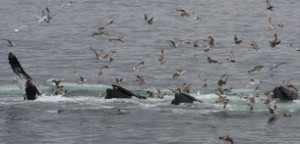
would only have to leave the harbor before we would come across dozens of humpback whales blowing bubble clouds to trap their prey. We would watch the water anxiously, waiting for columns of green bubbles to rise to the surface. Soon after, a humpback would emerge through the center of the bubble cloud, its mouth wide open, its ventral pleats expanded and full of fish!
Another cetacean frequently spotted during our springtime trips is the elusive harbor porpoise. These are the smallest whales we could hope to see in the area, and we often see their triangular dorsal fins dotting 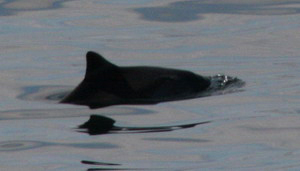 the surface of the water, particularly as we round Long Point at the tip of Cape Cod before venturing westward into Cape Cod Bay.
the surface of the water, particularly as we round Long Point at the tip of Cape Cod before venturing westward into Cape Cod Bay.
We are often amazed by how quickly we can reach the whales in the spring. I recall an extreme example of this, when, in the spring, eating lunch at a restaurant in whose dining room overlooks Provincetown harbor, I glanced up from my salad just in time to see the spout of a fin whale cruising by Long Point!
By the time Junearrived, most of the whales had moved out of the Bay, and the Dolphin Fleet boats took passengers farther north in order to see our famed cetaceans. Upon reaching Race Point, we sometimes headed east in order to see the enormous fin whales. As Cape Cod was formed by a retreating glacier at the end of the last ice age, and this has a lot to do with why we can find whales so close to shore. Rather than sloping gently into the sea, the land drops off very quickly. To put it in perspective, there are areas where you might be 50 feet from shore in over 100 feet of water! This vertical edge creates an ideal place for upwellings to occur. As currents hit an underwater obstruction, they pull circulate nutrients, setting off a chain reaction of productivity, and ultimately creating an ideal feeding ground. This happens quite a bit between Race Point Light in Provincetown and Highland Light in Truro in an area we sometimes call “finback alley.”
June was a great time to see finback whales, which are the second largest animals on the planet, plowing through schools of fish near Race Point. Like humpbacks, fin whales lack teeth and instead make use of baleen plates in their mouth, which cumulatively act as a strainer. Fin whales feed in a slightly different
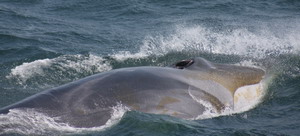
manner than the bubble-feeding humpbacks. Fin whales tend to swim in circles around their prey and then use a burst of speed to lunge through the corralled fish.
By June we had accumulated enough photographic data that our resident fin whale expert, John Conlon was able to determine that three different fin whales had returned this summer with calves in tow. We also were able to recognize several individuals that we knew from previous years. Lightning is a male first seen here in 1979. Braid, another male, was first photographed here in 1980. And Scorpion, a female who had her second known calf last year, was first recorded here in 1981. Other known individuals sighted this year are Belt, Boomerang, Comb, Delta, and Spike.
Fin whale mom and calf
Heading north toward the Stellwagen Bank National Marine Sanctuary, we were more likely to find humpback whales. This is a prime feeding ground for humpback whales, particularly mother and calves. While some members of the population might go farther north to forage for the energy-rich herring, humpback mothers have more immediate energy requirements after giving birth to one-ton calves, and sand lance are more readily available in more southern feeding grounds such as Stellwagen Bank.
Over the course of the season, naturalists on the Dolphin Fleet photographed and documented 48 different mother and calf humpback pairs in and around the Stellwagen Bank National Marine Sanctuary, but arguably the most exciting was the initial sighting of Salt. Named for the distinctive streak of white along her dorsal 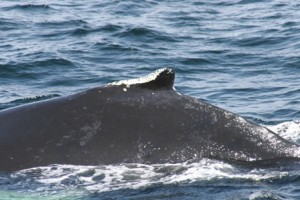 fin, Salt was the first whale to get a name in 1976. She was named by Dolphin Fleet whale watch captain Aaron Avellar, and we’ve been watching her return to her favorite feeding ground year after year. This year, she came back with her 11th known calf, Sanchal. In general, calves have to wait a year before they receive an official name, but there is a special exception for Salt’s offspring. Aaron Avellar’s family has the esteemed privelege of naming Salt’s calf, and they chose the name Sanchal because it is a type of black salt mined in the mountains of India and Pakistan.
fin, Salt was the first whale to get a name in 1976. She was named by Dolphin Fleet whale watch captain Aaron Avellar, and we’ve been watching her return to her favorite feeding ground year after year. This year, she came back with her 11th known calf, Sanchal. In general, calves have to wait a year before they receive an official name, but there is a special exception for Salt’s offspring. Aaron Avellar’s family has the esteemed privelege of naming Salt’s calf, and they chose the name Sanchal because it is a type of black salt mined in the mountains of India and Pakistan.
Our humpback whales continued to feed voraciously into July, and we continued to watch humpback whales blow huge rings of bubbles to corral schools of fish traversing the southern portion of Stellwagen Bank. On some days, we could actually see the huge masses of sand lance in the whales’ mouths as they came up through the bubble clouds. With each mouthful, a humpback might engulf several hundred gallons of food! 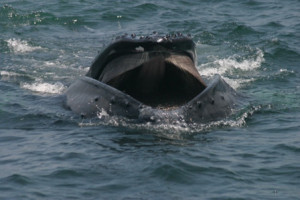
One particularly dramatic whale watch occurred in early July when the Dolphin VIII came across Ebony, a humpback whale who had become entangled in fishing gear. we came across one of the more unfortunate sights out in Stellwagen Bank–a humpback whale that had become entangled in fishing gear. Upon noticing that the humpback whale, a female named Ebony, had yellow line draped across its back, the naturalist aboard the Dolphin VIII immediately called the disentanglement team at the Provincetown Center for Coastal Studies. As the team got ready to head out for a disentanglement attempt, whale watch boats in the area took turns staying with Ebony so that the team would be able to locate her.
Fortunately, Ebony was feeding at the surface, which was a good sign not only because it showed that the line was not completely restricting her important life activities, but also because it allowed the disentanglement team to approach the whale and use a long pole with a knife attached to cut some of the line off of Ebony’s body.
Although the team wasn’t able to remove all of the gear, the goal in a disentanglement is to make a few strategic cuts that will allow the animal to free itself of gear on its own. This reduces the risk of creating a number of shorter lines that could further entangle the animal. Ebony was seen later that week and it is thought that the remaining line should come off the animal soon. To learn more about the disentanglement program, visit their website and read the related article about this disentanglement.
Another unusual sighting occurred when, on July 11th, a North Atlantic Right Whale was spotted just off of Long Point in Provincetown. At this time of year, most of the right whales in the North Atlantic are either in the Great South Channel east of Nantucket, or are on their way up to the Bay of Fundy to feed for the remainder of the summer. For reasons unknown to us, this one particular right whale was breaching away, much to the surprise of everyone aboard the whale watch boats.
By August, the daily bouts of surface feeding had largely subsided, but there was still plenty of near-boat activity to grab the attention of whale watchers in the height of the summer season. Humpback whale calves were getting larger by the day, and while they still remained close to their mothers, they continued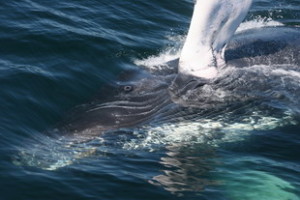 to express curiosity about the boat, and could frequently be seen lobtailing, playing with seaweed, and breaching, much to the delight of Dolphin Fleet passengers.
to express curiosity about the boat, and could frequently be seen lobtailing, playing with seaweed, and breaching, much to the delight of Dolphin Fleet passengers.
Although they seem to have been less common this year, compared with other years, we saw a number of Minke whales in August, particularly on some of the rougher days. Normally elusive and hard to see, there is something about rough seas that seems to inspire Minke whales to breach. We fondly recall several gray, blustery days in August when we would watch Minke whales, the second smallest baleen whale, leap out of the water, its pectoral flippers pressed to its side, only to belly-flop back down again!
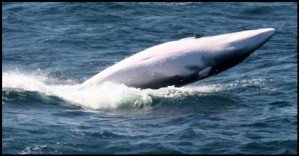 One particularly notable Minke whale sighting occurred in August when a Minke whale actually approached the boat and swam back and forth underneath the bow. In general, Minke whales are very elusive, and when we see them, it is typically only during their brief surfacing when their pointed rostrums break the surface and they quickly dive again. It was the only time that this naturalist could recall getting such a prolonged look at a single Minke whale.
One particularly notable Minke whale sighting occurred in August when a Minke whale actually approached the boat and swam back and forth underneath the bow. In general, Minke whales are very elusive, and when we see them, it is typically only during their brief surfacing when their pointed rostrums break the surface and they quickly dive again. It was the only time that this naturalist could recall getting such a prolonged look at a single Minke whale.
Additionally, by August we had noticed an anomaly in some of our summer bird populations. Shearwaters are a pelagic species frequently seen on Stellwagen Bank. Greater and sooty shearwaters are common visitors, while on a typical day in August a few Manx shearwaters are to be expected. This year we had an unusually high number of Cory’s shearwater. Slightly bulkier than the greater shearwater, Cory’s shearwaters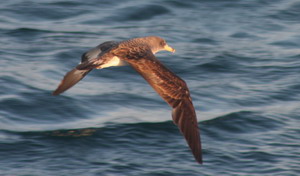 can also be distinguished by their bright yellow bill. They are trans-Atlantic migrants who next in the Mediterranean, and they are generally associated with the warmer waters around Martha’s Vineyard. Shearwaters and humpbacks are frequently seen in association with one another as they both feed on small schooling fish like the sand lance.
can also be distinguished by their bright yellow bill. They are trans-Atlantic migrants who next in the Mediterranean, and they are generally associated with the warmer waters around Martha’s Vineyard. Shearwaters and humpbacks are frequently seen in association with one another as they both feed on small schooling fish like the sand lance.
By September, it became clear that most of the humpbacks’ prey sources had moved areas deeper in the water column, as we started to see signs of bottom feeding. Our humpbacks would often go on slightly longer dives, only to emerge with their jaw lines abraded from the effort of foraging for food at the sandy, gravelly ocean floor. Sand lance spend much of their times burying themselves in the sandy substrate, and 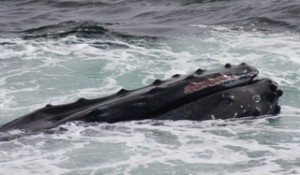 humpbacks will use their powerful jaws to scrape the ocean floor and agitate the fish enough to swallow mouthfuls of them. We can see the scars from this bottom-feeding behavior on their lower jaws, most frequently on the right side.
humpbacks will use their powerful jaws to scrape the ocean floor and agitate the fish enough to swallow mouthfuls of them. We can see the scars from this bottom-feeding behavior on their lower jaws, most frequently on the right side.
As September progressed, we began to return to the same group of animals on a regular basis, and we became fascinated with the every changing social dynamics of the group. Almost every day we were able to find Whisk and Canopy together. Both Whisk and Canopy are females and they each have calves this year. Canopy’s 2008 calf is her first, while Whisk’s is her fifth. More often than not, this group of four was joined by Pele, Milkweed, and sometimes Draco or Lupine.
Last year at around the same time period, Milkweed was frequently seen in the company of Hancock, Perseid, and their respective calves. Male humpbacks that associate with mother and calf pairs tend to have better reproductive success, so perhaps Milkweed is accompanying these animals in hopes of successfully mating during the winter.
The two calves were the other obvious source of awe for this group. Often, while the adults would go foraging for food, the calves could be seen rolling, flipper slapping, and sometimes even breaching, perhaps in an effort to draw their mothers’ attention, or perhaps just to play and have fun.
Calves at play
Whisk’s Calf flipper slapping
By October, we continued to see the same group of humpbacks regularly, while also getting a chance to see some of our old favorites, including Salt and Sanchal, as well as Apostrophe and calf. We often remarked on how huge the calves had gotten since we first saw them in April. In a few months, they will be leaving their mothers and going off on their own. If we see them next year, we’ll photograph them, document them, and then they will receive an official name in April of 2010.
As the humpbacks prepare to head back down to the mating grounds, hormones sometimes kick in early and towards the end of October we started to see more apparent socializing. Groups of humpbacks could sometimes be seen rolling and spyhopping at the surface, often appearing like they would collide!
Before the end of the season we also were lucky enough to catch a few more bouts of surface feeding. One day, we headed to the center of Stellwagen Bank, just south of the Boston shipping lane. It was clear enough that the Boston skyline was just visible on the horizon, and we watched as humpbacks blew bubble nets, kicked the water, and continued to feast on sand lance before their 1,500 mile journey that they will be embarking on starting in December.
High winds and rough seas kept us on shore, and our season ended in mid-October, but we are looking forward to next year when we hope to see old favorites back with calves, and this years calves off on their own. In the meantime, we have a whole season of data to pour over. This year on the Dolphin Fleet alone we identified 307 individual humpbacks, including 48 mother and calf pairs. We also have a number of unknown individuals that we will spend more time trying to match this winter. Check back with us next spring when the Dolphin Fleet will start up again in mid-April!






